Purr-fect Paintings: 15 Famous Cats in Art History
- 1. Louis Wain's Festive Feline Gathering
- 2. Franz Marc The White Cat
- 3. Hiroshige II: A White Cat Playing With a String
- 4. Suzanne Valadon, Raminou
- 5. Marc Chagall, La Poete
- 6. Pablo Picasso's Cat Catching A Bird
- 7. Min-Zhen The Black Cat
- 8. Henriette Ronner Knip is the Cat at Play
- 9. Bart van der Leck, The Cat
- 10. Julie Manet, also known as Child with Cat and Pierre-Auguste Renoir
- 11. Marguerite Gerard's The Cat's Lunch
- 12. The White Cat by Pierre Bonnard
- 13. Utagawa Kuniyoshi: Cats are Suggested as the Fifty Three Stations of the Tokaido
- 14. Theophile Steinlen The Chat Noir
- 15. Jeff Koons: Cat on a Clothesline
- 16* Pimpa The Cat
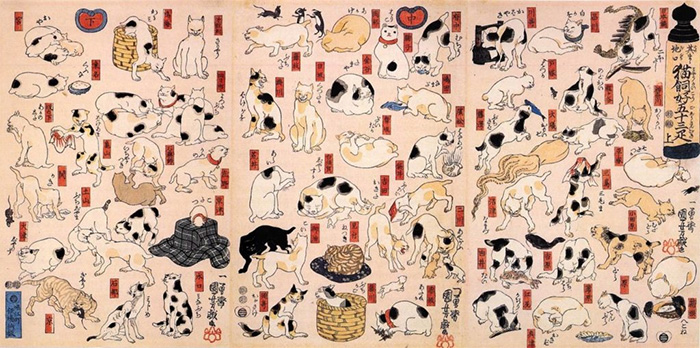
As a devoted caretaker of Pimpa, arguably the most laid-back kitty on the planet, I'm on a mission to celebrate all things feline. I've curated 15 iconic feline artworks from history that every cat aficionado would love to see.
While some artworks place cats front and center, others subtly incorporate them. Honestly, cats are always the main attraction because they're the true rulers of the cosmos. Let’s dive in!
1. Louis Wain's Festive Feline Gathering
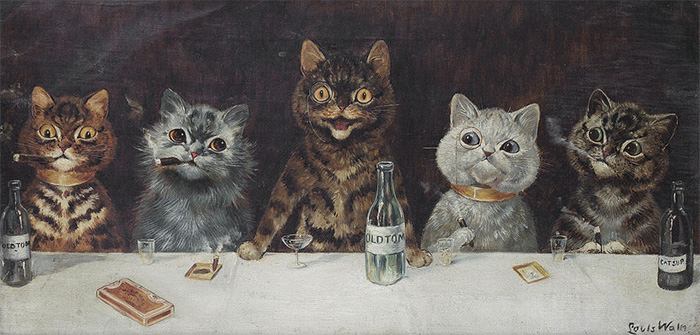
Louis Wain's feline illustrations are deserving of a dedicated feature. Wain stands out as one of the most renowned British artists. Born in 1860, he gained fame for his human-like portrayals of cats. The famed British writer, H.G. Wells, remarked that Wain "crafted a unique feline aesthetic, envisioned a cat-centric society, and birthed an entire universe dominated by cats." But Wain had schizophrenia, which could have been the cause of his obsession with cats.
He was known as a cat expert and was even elected President of the National Cat Club. He also judged cat contests and worked with several animal charities. He produced hundreds of drawings every year for almost 30 years. They still amuse art and cat lovers.
2. Franz Marc The White Cat
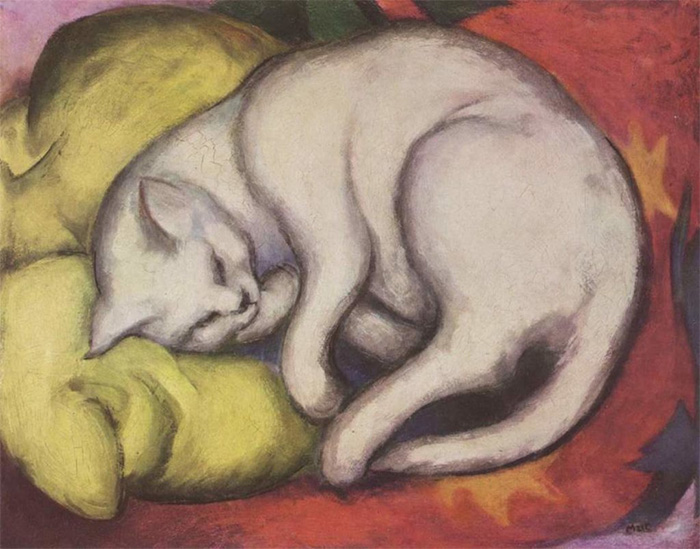
Franz Marc is best known for his brilliantly colored images of animals, including horses, dogs, and cats. Marc exhibited his work in Munich between 1911 and 1912. Marc's paintings depict cats in their natural sleeping or grooming state. His famous cat paintings include cats on pillows, two blue and yellow cats, cats in baskets, and cats on red cloth.
Animals symbolize purity, honesty, and beauty. He also believed that colors had meanings - yellow was for happiness and femininity, while blue represented spirituality.
3. Hiroshige II: A White Cat Playing With a String
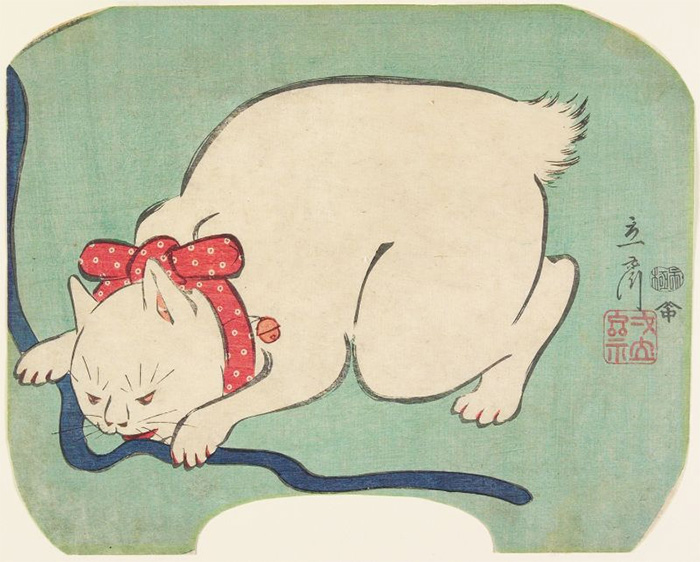
This is an unusual fan print created by Hiroshige, who closely followed his mentor's style and design (who, of course, was also named Hiroshige). This print is a reflection of Hiroshige's unique style.
The artist has captured a housecat in an abstract and bold manner. This adorable and chubby white bobtail is biting on a blue thread. He appears ready to pounce with his hind legs pressed against the ground. You will recognize this cat's facial expression if you own a cat.
4. Suzanne Valadon, Raminou

Suzanne Valadon hails from France and is celebrated for her artistic prowess. In 1894, she made history by becoming the inaugural female Societe Nationale des Beaux-Arts member. Valadon's creations, spanning landscapes, inanimate objects, individual portraits, and floral depictions, are recognized for their vivid hues and robust layouts.
Her most acclaimed pieces are unfiltered portrayals of female nudes, offering a perspective through a woman's eyes. A feline enthusiast, she frequently incorporated cats into her art, with her beloved plump cat, Raminou, often taking center stage.
5. Marc Chagall, La Poete

A Jewish pioneer and modernist, Marc Chagall, experienced the "golden age of modernism" in Paris. He synthesized Cubism with Symbolism as well as Fauvism and Surrealism. In his lifetime, Chagall used a variety of motifs and themes in his paintings: peasant scenes, village scenes, and intimate views of the Jewish village. All of these were presented in an unreal, dreamy manner.
Many of his works feature cats, which help to emphasize their fantastical nature. Cats often accompany the figures he painted, such as women, poets, or musicians.
6. Pablo Picasso's Cat Catching A Bird

Picasso's Cat Catching a Bird appeared in two versions during the war in 1939. Picasso said, "The topic obsessed me. I don't understand why". The bird tries desperately to escape from the grip of its tormentor. The neutral background doesn't lessen the horror. This is a picture of everyday life taken to apocalyptic levels. The cat wants to delay killing the birds as long as he can.
7. Min-Zhen The Black Cat
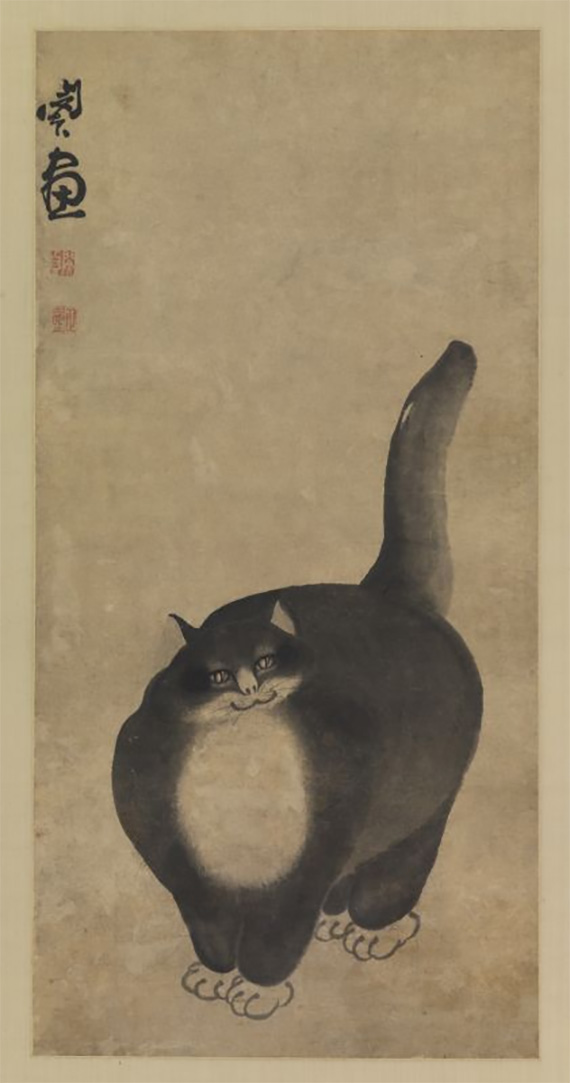
Picasso's cat is a mean one. It's time to have a happy one! Min Zhen, a Chinese seal carver and painter, was born in Nanchang in Jiangxi. He spent the majority of his life living in Hubei. He is known for his finger paintings and human figures.
He was an orphaned child associated with The Eight Eccentrics Of Yangzhou. This is the name of a group of Chinese painters who, in the Qing Dynasty, were known for their rejection of traditional ideas of painting and for adopting a more expressive and individualistic style.
There was little information available about this beautiful, chunky cat. Perhaps no further comments are required. He has eaten all of the cat food on the planet and is now happy.
8. Henriette Ronner Knip is the Cat at Play

Henriette Ronner Knip was a painter born into a painting family in Amsterdam. She is best known for her paintings of domestic cats. Such pictures were very popular in Victorian times, especially with wealthy bourgeois. Her paintings of cats causing mischief and causing chaos in domestic scenes became favorites.
Her paintings are mainly sentimental and focus on cats. They rarely have any symbolic meaning. She studied the cats she painted with passion and sincerity. She went as far as building a studio with a glass front where cats could run around, sleep, and cause mischief.
9. Bart van der Leck, The Cat
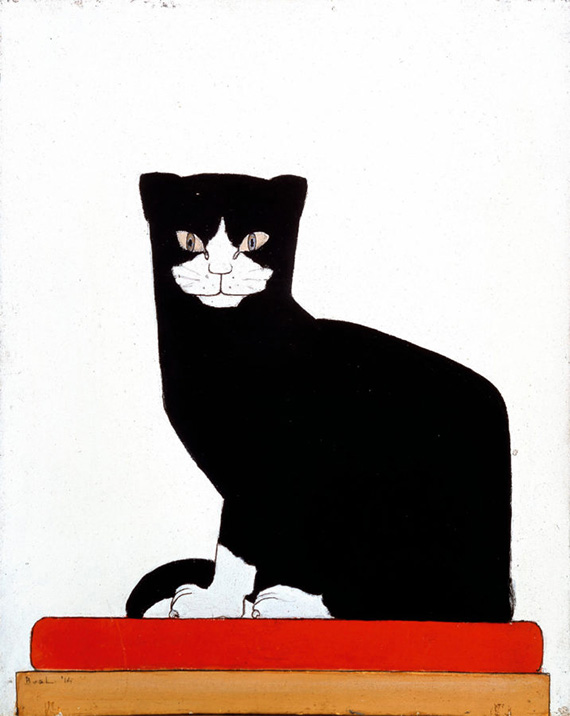
Bart van der Leck was the co-founder and editor of De Stijl magazine. Like Piet Mondrian in 1916, Bart van der Leck chose radical abstraction and the primary colors red, yellow, and blue for his work. This choice was preceded by a search for a new visual language. A visit to Paris led him to be impressed by the classical Egyptian art at the Louvre.
Inspired by this, he created a style of highly simplified shapes and sober colors. Van der Leck used black, white, red, and orange to depict the cat both in profile and from the side in The Cat.
10. Julie Manet, also known as Child with Cat and Pierre-Auguste Renoir

Pierre-Auguste Renoir had been a friend of Berthe Morisot's husband, Eugene Manet, for many years. In 1887, the Manets were so impressed by Renoir's talent that they commissioned a portrait of Julie. It's only a cat, but it is a very sweet one. It also looks happier than Julie. Like many American art lovers, she may have disliked Renoir's works a century later.
11. Marguerite Gerard's The Cat's Lunch

Here is what my cat looks like when I feed him. Marguerite Gerard produced oil paintings and engravings under the supervision of her great brother-in-law, Jean-Honore Fragonard. He may have convinced her to include cats in her compositions, as he is also known for this. Gerard was a genre painter who specialized in depicting intimate scenes from domestic life.
Unlike many other female painters, Marguerite Gerard often used settings and costumes from centuries before. Her paintings often depict the experience of motherhood, childhood, and the family. Several also focus on the importance of music and female companionship. As we can see from this painting, cat companionship is also in the focus.
12. The White Cat by Pierre Bonnard
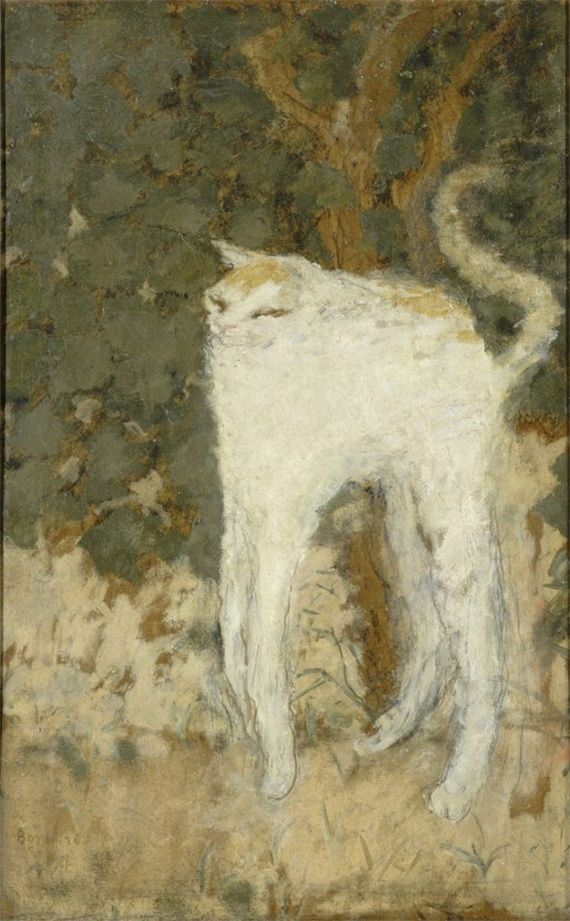
Pierre Bonnard created a funny image by using distortion. This cat is arching its back. As seen from the preparatory sketches, the painter took a lot of time to decide on the shape and position of the cat's paws. The bold, asymmetrical composition and the subject matter - popular in Bonnard's prints - are Japanese influences.
Hokusai, Kuniyoshi, and other artists, some of whose works you will also see in this article, have painted cats. Bonnard painted countless paintings with cats. Sometimes, they were a small detail visible in varying degrees, and sometimes the cat was the main subject.
13. Utagawa Kuniyoshi: Cats are Suggested as the Fifty Three Stations of the Tokaido

This triptych print by Japanese illustrator Utagawa Kuniyoshi features 55 cats. One crawls from a basket. Others eat fish. Kuniyoshi loved cats. His students noticed his studio had become overrun with cats when he began teaching. In his best prints, he shows his love for cats. They can be seen as well-known characters in stories or as expressive studies. Kuniyoshi often depicted cats in an anthropomorphic shape, like the later Louis Wain.
The Cats Suggested As the Fifty-three Stations of the Tokaido parody is a fun take on Hiroshige’s The Fifty-three Stations of the Tokaido, the best-selling collection of ukiyo-e in history. The Tokaido, or "Eastern Sea Road", had 53 post stations that provided travelers with food, lodging, and stables. Kuniyoshi chose to illustrate these stations with cat puns.
Miya, for example, is the name of the 41st Tokaido station. The name resembles the Japanese word oya, which means "parent". The station is portrayed as two kittens and their mother.
14. Theophile Steinlen The Chat Noir

Le Chat Noir, a 19th-century entertainment venue in Paris' bohemian Montmartre neighborhood, was founded by Rodolphe Salis. The impresario Rodolphe Salis opened it on 18 November 1881, at 84 Boulevard de Rochechouart. It closed in 1897, not long after Salis died. It's believed to be the world's first cabaret, a nightclub where patrons would sit at tables while drinking alcohol and watching a variety show.
This iconic Theophile-Steinlen poster promotes a nightclub, which was a mix of an artist's lounge and a music hall in its heyday. The Cabaret, from 1882 to 1895, published a magazine with the same title, which featured literary writings, news about the cabaret, Montmartre, and poetry. Throughout Paris, you can buy reproductions of the cat.
15. Jeff Koons: Cat on a Clothesline
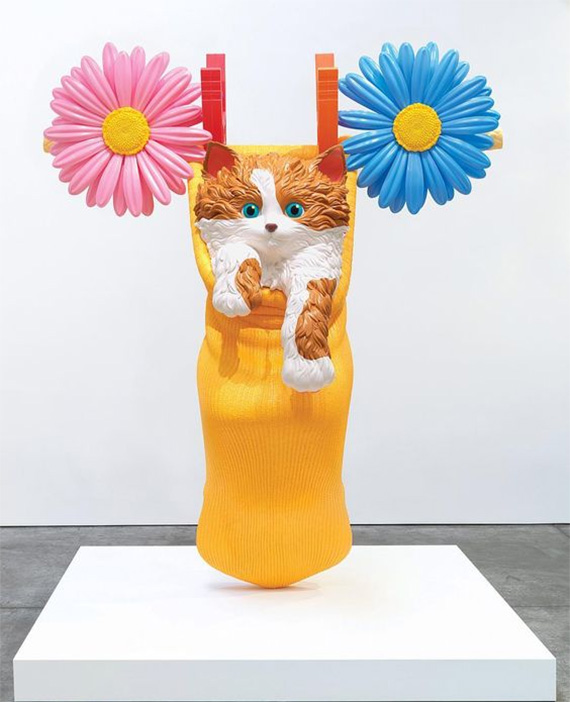
You can't ignore Jeff Koons' art, regardless of whether you like him. It's hard to tell from this picture, but Jeff Koons' Cat on a Clothesline measures 312.4 x 279,4 x 127cm. For Koons, This artwork is "like a modern crucifixion". It's a cute little kitten, just a sock. You can think of it like a womb and feel that sense of security. It's up to you to decide what it means to you.
16* Pimpa The Cat
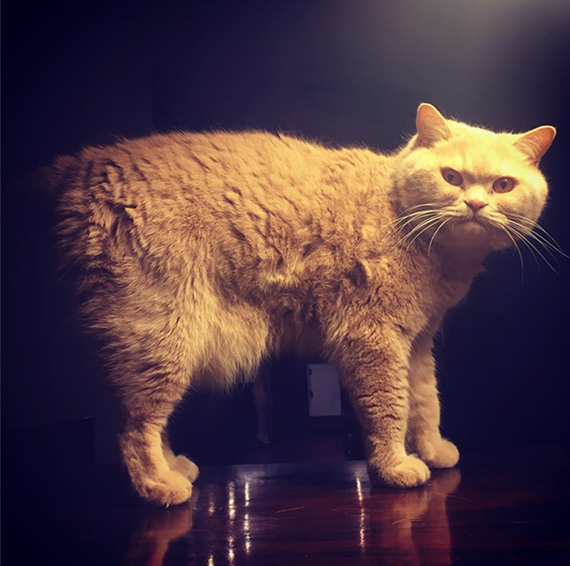
Pimpa is the biggest supporter of DailyArt. I would have loved to see his portrait painted by one of the Golden Age Dutch masters! Hieronymus Bosch could have done it as well. I had to show my cat after all these wonderful examples of cats in art history.
No Comments Yet...